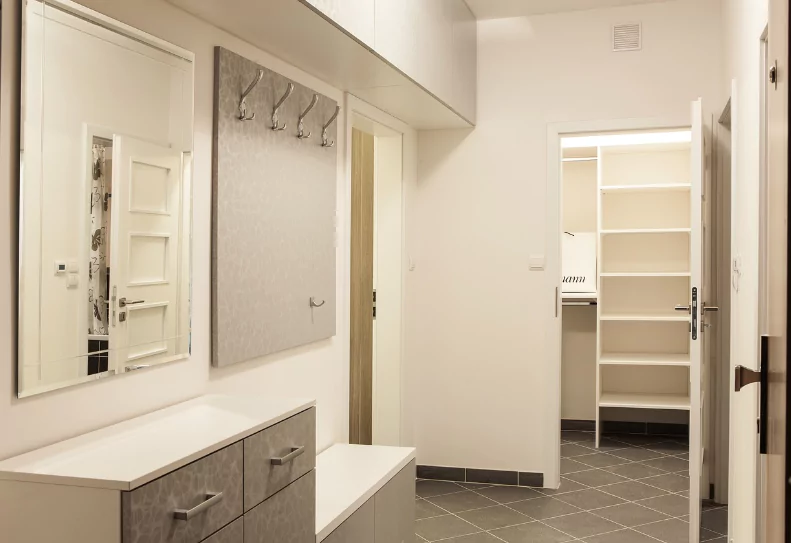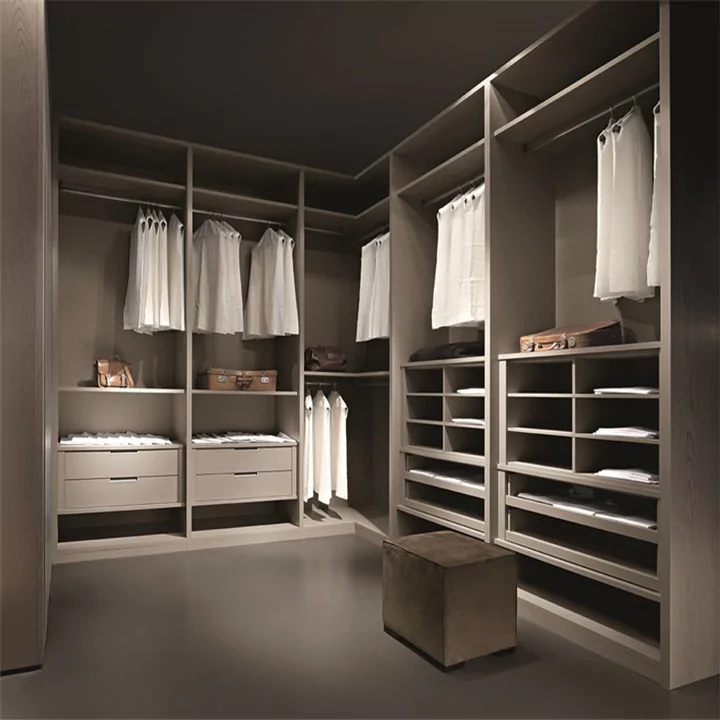Wardrobe Design Strategies: Maximizing Functionality and Style

The art of wardrobe design encompasses a myriad of strategies aimed at maximizing both functionality and aesthetics in personal storage solutions. By tailoring each layout to individual preferences and spatial constraints, designers can create efficient yet stylish wardrobe systems suited for various lifestyles. This article will explore essential principles of wardrobe design, material selection, the significance of space planning, and trusted manufacturers, particularly in the context of creating versatile wardrobe spaces.
The Essentials of Wardrobe Design
Defining Wardrobe Design Principles
Wardrobe design principles serve as the foundational guidelines that inform the aesthetic and functional components of wardrobe layouts. Principles such as balance, harmony, and proportion play crucial roles in ensuring a pleasing visual flow while providing easy access to clothing and accessories. Effective wardrobe design also involves thoughtful organization strategies that simplify the process of finding and storing items. Ultimately, a well-designed wardrobe balances style and functionality for an organized living space.
Key Elements to Consider in Wardrobe Layout
When considering wardrobe layout, several key elements must be prioritized. Firstly, assessing available space is essential to determine dimensions, door swing directions, and overall usability of the area. Additionally, appropriate allocation of storage types—such as hanging, shelving, and drawer space—ensures items are easily accessible. A clear separation of different clothing categories, like formal wear and casual attire, facilitates an efficient organization system. Lastly, lighting should not be overlooked; natural and artificial light sources significantly influence wardrobe usability and the overall aesthetic.
Importance of Personalization in Wardrobe Organization
Personalization is a cornerstone of effective wardrobe design, wherein solutions are tailored to meet the unique needs and preferences of individuals. Users have diverse storage requirements based on lifestyle choices, such as professional attire, sports gear, or travel essentials. Customizable features enable clients to incorporate specific compartments like shoe racks, tie holders, or accessory trays, enhancing practicality. Furthermore, engaging users in the design process facilitates a stronger connection to their space and promotes sustained organization and cleanliness.
Choosing the Right Materials
Types of Materials Commonly Used in Wardrobes
Material selection is pivotal in wardrobe design, as it affects both durability and visual appeal. Common materials used in wardrobes include wood, metal, and glass, each lending unique characteristics to the final product. Wood remains a timeless choice, valued for its natural richness and customization potential. Metal adds a contemporary feel and durability, while glass elements provide an elegant touch, often used in sliding door applications.
Wood
Wood is frequently the material of choice for wardrobes due to its versatility in styling and finishes. Various species like oak, walnut, and maple can be custom stained or painted, allowing compatibility with existing décor. Additionally, wooden wardrobes can be designed with different textural effects, enhancing character and depth.
Metal
Metal components can significantly contribute to the sturdiness and modern appeal of wardrobe systems. Options such as aluminum and steel can be incorporated in frameworks or as accents, providing a sleek aesthetic while supporting functionality. Metal is particularly effective in modular designs, making it a smart choice for contemporary spaces.
Glass
Glass is an excellent option for enhancing visibility and elevating design sophistication. Used either for full doors or as a display component, glass elements allow items within the wardrobe to be showcased, creating a visually curated space. It’s important to consider tempered or frosted glass for safety and privacy.
Pros of Different Materials
Each material presents its advantages that warrant consideration. Wood offers warmth and rustic charm, making it ideal for traditional or farmhouse styles. Metal provides industrial beauty and resilience, capable of withstanding the rigors of daily use. Glass, with its inherent elegance, can visually open up spaces and provide a modern aesthetic. The decision ultimately lies in balancing personal preference with practical considerations like maintenance and durability.
Selecting the Trusted Cabinets Manufacturer: Refor
About Refor
Refor is a reputable manufacturer known for its high-quality cabinetry solutions tailored to various needs and styles. With a strong emphasis on personalization and functionality, Refor ensures that every wardrobe design harmonizes perfectly with the surrounding space. Its extensive range of products features customizable elements, combined with innovations in design and material use.
Walk in Robes Designs
A walk-in closet is essentially a dedicated room that is organized and accessorized with a variety of storage elements to hold clothes, shoes, and accessories. Unlike traditional wardrobes or built-in wardrobes, walk-in closets offer a more spacious and open environment, allowing homeowners to easily see and access their belongings.
The key to a good wardrobe design is functionality. A well-designed wardrobe should not only look stylish but also be practical and easy to use. This is where customization comes in. Refor, a company specializing in wardrobe design, focuses on customization to ensure that each wardrobe is tailored to meet the specific needs and preferences of the homeowner. Whether it’s a traditional wardrobe, a built-in wardrobe, or a walk-in closet, Refor’s designers work closely with their clients to create a storage solution that is both functional and stylish.
Shipping Arrangement
Quality customer service and efficient shipping arrangements are paramount for any cabinetry manufacturer, and Refor prioritizes swift delivery and installation processes. Their logistics are strategically optimized to facilitate the smooth transport of products to clients, ensuring that installations are conducted in a timely and organized manner.

Space Planning and Optimization
Techniques for Efficient Space Utilization
Maximizing wardrobe space begins with planning and creative layout solutions. Employing techniques like utilizing vertical space, incorporating adjustable shelves, and conscious implementation of drawers and pull-out units can make a significant difference in usability.
Utilizing Vertical Space
In wardrobes, verticality is an often-underused area that can dramatically increase storage capacity. High-mounted shelves can accommodate seasonal items or infrequently used objects while hanging space can be extended with additional rods for layered organization.
Incorporating Adjustable Shelves
Adjustable shelves provide the flexibility to adapt to varying storage requirements over time. They allow users to modify their wardrobe configuration as their needs change, fostering a long-term investment in functionality that remains relevant across different life stages.
Implementing Drawers and Pull-out Units Consciously
Drawers and pull-out units enhance accessibility across wardrobe spaces, especially for smaller items that can easily become lost in larger sections. Thoughtful incorporation of these elements allows for maximum space utilization while keeping items organized and readily available.
Specific Solutions for Small Spaces
When space is limited, creative solutions come to the forefront. Consider designing wardrobes with sliding doors to eliminate the need for door swing clearance. Additionally, recessed wardrobes can integrate into walls, saving precious square footage. Opting for multi-functional furniture—like ottoman benches that double as storage—also maximizes every available inch, catering specifically to smaller rooms.
Accessories and Add-ons for Enhanced Functionality
Incorporating Lighting Solutions
Effective lighting is paramount in wardrobe design as it not only improves visibility but also enhances the overall aesthetic appeal. Thoughtful implementation of lighting solutions involves using a combination of ambient, accent, and task lighting to create an inviting atmosphere. For instance, integrated LED strip lighting along shelving can illuminate stored items, making them easily identifiable while adding a contemporary flair. Additionally, motion-sensor lights can be particularly beneficial in walk-in wardrobes, automatically illuminating the space as the doors are opened, thus ensuring functionality without compromising on energy efficiency.
Another consideration is the use of illuminated mirrors, which can serve a dual purpose by functioning both as a decorative element and a practical tool for dressing. These mirrors can be fitted with adjustable brightness, providing optimal lighting for outfit selections. Strategically positioned lighting can also highlight decorative features or personal collections within the wardrobe, thereby blending functionality with personalized artistry.
Furthermore, proper lighting placement should take into account the color temperature, as cooler tones may enhance visibility for selecting clothes, while warmer tones can create a cozy atmosphere. By investing in quality lighting solutions, designers can transform ordinary wardrobe spaces into visually striking displays, promoting style without sacrificing utility.
Specialized Compartments for Accessories and Jewelry
Designing wardrobes with specialized compartments for accessories and jewelry significantly enhances the functionality of the space. By integrating dedicated sections such as velvet-lined drawers, trays for watches, and racks for bracelets and necklaces, individuals can ensure their items are stored dutifully and safely. This organization helps prevent tangling and damage, allowing for easy access and visibility to all items stored within the wardrobe.
Moreover, specialized compartments extend beyond jewelry and can include designated sections for belts, ties, and scarves. This level of detail not only promotes organization but also creates a refined space where all items are accounted for. The integration of custom storage solutions facilitates a personalized experience that aligns with the user’s lifestyle, ultimately enhancing overall satisfaction with the wardrobe design.
Sustainable Wardrobe Design Practices
Environmentally Friendly Material Choices
In today’s design landscape, there is a growing emphasis on sustainability and eco-friendly practices in wardrobe design. Utilizing environmentally responsible materials such as sustainably sourced wood, recycled metal, and eco-friendly finishes can significantly reduce the ecological footprint of wardrobe manufacturing. By prioritizing materials that are both renewable and non-toxic, designers contribute to a healthier indoor environment while supporting responsible forestry practices.
Another consideration in selecting environmentally friendly materials is durability. Well-constructed wardrobes made from high-quality materials tend to have longer lifespans, reducing the need for replacements and minimizing waste. Designers should consider finishes that are low in volatile organic compounds (VOCs) to ensure better air quality and reduce the harmful impact on inhabitants.
Durable Designs for Long-Term Use
In addition to selecting sustainable materials, integrating durability into wardrobe design is vital for longevity and function. High-quality construction techniques, along with robust hardware like Blum or Hafele fittings, contribute substantially to resilience over time. A focus on durability ensures that wardrobe systems can withstand daily use without compromising appearance or functionality.
Moreover, investing in timeless designs—those that don’t follow fleeting trends—ensures that the wardrobe remains relevant and appealing even as personal styles evolve. Minimalist aesthetics with clean lines and classic color palettes can seamlessly coexist with various decor styles, making them a worthwhile long-term investment.
Emerging Trends in Modern Wardrobes
The landscape of wardrobe design is continuously evolving, reflecting changes in lifestyle, technology, and preferences. Emerging trends often center around maximizing both functionality and aesthetics while incorporating innovation. Contemporary designs increasingly turn to modular systems that allow homeowners to customize their wardrobe layout according to personal needs and available space.
Sustainability as a Core Value
Lastly, sustainability continues to be a recurring theme within modern wardrobe designs. As consumers become increasingly conscious of their environmental impact, simplicity and minimalism are favored—opting for timeless aesthetics that prioritize eco-friendly materials and processes. As designers align with these growing values, they create wardrobes that not only serve practical purposes but also reflect a broader commitment to sustainability in interior design.
In summary, effective wardrobe design requires careful consideration of numerous factors, ranging from lighting and mirrors to sustainability and technology. This comprehensive approach ensures that wardrobes not only meet individual desires for style and organization but also contribute positively to living spaces for years to come.

